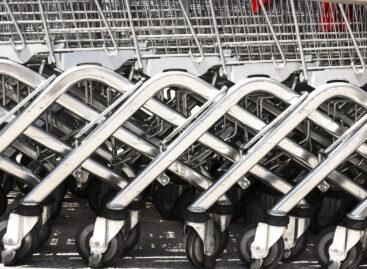After temporary stabilization, the outlook for the domestic food industry is uncertain again
In recent years, the Hungarian food industry has been in the spotlight due to explosive price increases and government regulations. Although 2024 brought more stability compared to previous years, the margin cap introduced in spring 2025 shows that the “interesting times” are far from over. Once again, we have assessed the state of the industry, with a particular focus on the financial performance of the most important domestically owned players and on analysing the key events shaping their results. In addition to the 20 largest Hungarian food companies, we also examined two particularly dynamic sub-segments – i) producers of canned, preserved and frozen fruit and vegetables, and ii) manufacturers of confectionery, snacks and instant drink powders.
Stabilising macro environment
The shocks of 2022 and 2023 continued to shape the overall mood in 2024: according to data from the Hungarian Central Statistical Office (KSH), despite price control measures, food prices rose by more than 61% over the two-year period 2022–2023. In response, household consumption volumes fell by 17%, while production declined by 6%. From these levels the market managed to correct in 2024: based on Statistical Office data, food prices did not increase further last year, despite the abolition of mandatory promotions in June, while production volumes grew by 4% and household food consumption rose by 10%. These production and consumption figures indicate signs of stabilisation in the segment. However, production volumes still fall short of their 2021 level, and household consumption remains below pre-Covid values. Wage inflation also persisted in the food industry: wages in the sector increased by 12.9%, roughly in line with the national average. Although this represents a lower nominal rise than in previous years, it still places a significant burden on food manufacturers.

Top 20 food companies – Is the turnaround here to stay?

Bonafarm Group1: Consolidated financial data for the relevant Bonafarm Group companies (Sole-Mizo Zrt., Hungerit group, Pick Szeged Zrt., MCS Vágóhíd Zrt.).
Baromfi-Coop Group2: Consolidated financial data for the relevant group members (Sága Zrt. + Master Good Kft.).
Szatmári Group3: Consolidated financial data for the relevant companies in the group (Szatmári Malom Kft., Kunsági Malom Kft., Naszálytej Zrt.).
Taravis Kft.4: A subsidiary of Gallus Kft. The figures of Gallus Kft. are not included due to its different profile (poultry breeding).
Szatmári Konzerv + EKO Kft5: Due to a shared ownership background and coordinated operation, the two companies’ consolidated financial data are presented. The group members’ financial year ends on 30 June; in the 2020–23 columns the data from the reports as of 30.06.2021, 30.06.2022, 30.06.2023 and 30.06.2024 are shown respectively. For the years prior to the transition, the values are calculated for a June-to-June period based on the financial statements.
Steam Cook Kft + Várda Meat Kft6: They share the same parent company, Gerla Élip Kft. The two companies’ consolidated financial data are presented.
Lipóti Group7: Consolidated financial data of Lipóti Pékség Kft., Lipóti Sütőipari Kft. and Lipóti Tóth és Társai Kft..
The general increase in real wages led to an expansion in household consumption, as a result of which the 20 largest domestically owned food companies in our ranking increased their revenues by a median 5.6%. In a low-inflation environment this can be considered a particularly solid performance. According to KSH data, around 60% of the Hungarian food industry’s output is sold on the domestic market, which makes the sector highly sensitive to changes in internal demand: in 2023, the weaker demand was clearly visible in the performance of the companies on our list, as their revenue growth lagged far behind the rate of food inflation. In 2024, in contrast, on the back of a 10% increase in household food consumption volumes, 80% of the 20 companies examined grew their revenues, while 70% also improved their EBITDA-level profits.
Companies with significant export exposure (where more than 40% of revenues come from exports) performed above average within our Top 20: they achieved higher growth in 2024, and their profitability typically exceeded that of their mostly domestically focused peers by several percentage points. The superior performance of export-oriented firms can be explained by more stable external demand and by the distorting impact of domestic regulations on local markets. In addition to these factors, the 6.6% weakening of the forint also significantly contributed to strong export performance.
Partly as a consequence of state measures introduced in recent years, cheap imported products are providing growing competitive pressure, especially in categories that are less differentiated and harder to brand. The intensified competition from imports contributed to the below-average 2.4–2.5% median revenue growth of the dairy and meat players in our ranking and significantly limited their ability to pass on rising costs. In these segments, the median EBITDA margin reached only 4.5–5.5% in 2024, compared to around 10% or above in the other segments represented in our list.
After two consecutive years of decline, the median EBITDA margin of the Top 20 companies rose to 8.4%, surpassing the 7.3% recorded in 2022 and the 5.8% in 2023. It is worth examining the drivers of this improvement. While personnel expenses at the companies on our list increased by 17%, material-type costs (raw materials, energy, purchased services) grew by only 1.5%, well below revenue growth. As this is the largest cost category (79% of revenues) for the Top 20 (and for the food industry in general), this was the key factor behind higher profitability.
Among the fastest-growing companies on the list, the Lipóti Group had an outstanding year, increasing its revenues by 28% after opening Hungary’s largest-capacity bread, bakery and fine pastry production plant in Hatvan in 2023, designed to serve its nationwide store network. Hell Energy also closed a successful year with 21% revenue growth, supported by the completion of an 80 billion forint capacity expansion project in May 2024. A notable exception in the dairy sector was Köröstej, specialised in cheese production, which increased both its export (+17%) and domestic (+19%) sales, and – thanks to more efficient operations (personnel expenses up by only 9%) – successfully passed on a 12% increase in material costs, raising its EBITDA margin from 3% to 8%.
Canned, preserved and frozen fruit & vegetable producers – Strong growth, weakening profitability

Szatmári Konzerv + EKO Kft1: Due to a shared ownership background and coordinated operation, the two companies’ consolidated financial data are presented. The group members’ financial year ends on 30 June; in the 2020–23 columns the data from the reports as of 30.06.2021, 30.06.2022, 30.06.2023 and 30.06.2024 are shown respectively. For the years prior to the transition, the values are calculated for a June-to-June period based on the financial statements.
Based on shared characteristics (fruit/vegetable processing, high export exposure, predominantly domestic ownership), similarly to last year’s report we grouped together companies engaged in the production of canned, preserved, frozen and dried fruit and vegetable products. Among the companies we examined, the median revenue growth reached 11.8%, and only two firms recorded a decline in revenues in 2024. This outstanding performance is partly explained by the strong impact of exchange rates in this segment: 55% of the Top 11’s revenues come from exports, mainly to EU countries. Revenue growth was also supported by the sale of stocks produced and accumulated in previous periods.
Alongside strong revenue expansion, profitability softened somewhat: the segment’s median EBITDA margin fell from 8.1% in 2023 to 7.1% in 2024. In terms of cost structure, the share of material costs (around 80%) and personnel costs (around 10%) did not change significantly within the sample. However, the canned food industry was not spared from wage increases either: personnel expenses at the companies we analysed rose by 15%, above the 13.2% national average, and their share of revenues increased from 9% to 12% in 2024, contributing to margin erosion.
Even in this segment, there were standout performances. Jonaco, specialising in pickles and preserves and a key European player in canned sour cherries, increased its revenues by 28% and improved its EBITDA margin by more than 10 percentage points.
Confectionery, snacks and instant drink powders – Sweet Spot

Szamos Group1: Consolidated financial data for Szamos Marcipán Kft., Sós Karamell Kft. and Vanília Cukrász Kft.
Cerbona Group2: Consolidated financial data for Cerbona Zrt., Cerbona Webshop Kft. and A.R.M Alba Regia Mercator Kft. For A.R.M, only EBITDA was taken into account, as its (royalty) income is generated from the other group members..
Cornexi Group3: Consolidated financial data for Cornexi and Vitecer. They share the same parent company, E&K Investment Kft..
The Top 10 confectionery players increased their revenues by around 4% on a median basis, which is weaker than in previous years and slightly below the equivalent figure for the broader Food Top 20. The median EBITDA margin of the companies on our list, after falling from 10.4% to 9.2% in 2022–2023, rose to 11.1%, again driven by favourable material cost dynamics. The companies examined managed to reduce their material cost ratio despite the fact that prices for some key inputs (e.g. sugar, flour, eggs) continued to rise dynamically in 2024. In this segment, wage costs also increased significantly – by 19%, following 24% in 2023 – and their share of revenues rose from 15% to 17%, well above the average for the 20 largest food companies we analysed.
Two main factors lie behind the higher-than-average profitability of the 10 listed companies compared to the broader food industry (Top 20): relatively inelastic demand for confectionery products and the high share of branded items that can be sold with higher margins.
Alongside the segment’s overall stable performance, some players delivered outstanding results in 2024. The three largest companies on the list (Detki, Szamos, Tutti) all significantly improved their profitability, with Tutti Élelmiszeripari Kft. increasing its EBITDA by nearly 30%. PPP Private Powder Products Kft., which manufactures hot and cold instant drink powders, achieved the fastest growth of the past two years thanks to a production capacity expansion in 2023, and successful technological optimisation in 2024 led to nearly 60% EBITDA growth.
Conclusion and outlook
2024 brought a period of temporary calm for the food industry. Food price inflation stalled, market-distorting government price control measures were phased out from mid-year, and household consumption returned to growth – enabling most industry players to increase their revenues and improve profitability.
However, food producers did not enjoy this stability for long, as 2025 and the following years bring new challenges. While further growth in domestic and European consumption is expected, cost pressures remain – primarily due to double-digit wage inflation – and new regulatory measures have been introduced this year. Difficulties in agriculture (drought, frost damage, animal diseases) and the re-acceleration of food price inflation have triggered renewed government intervention. The margin cap introduced in March 2025 will affect not only retailers but also manufacturers at least until spring 2026. The unintended – quasi – transparency of supplier pricing is being used by dominant retail chains to push down producer prices, and the combination of cheaper, often lower-quality imports and the competition from private-label products poses a real threat to the position of branded Hungarian goods. The forint’s recent strengthening is primarily weighing on the growth prospects of export-oriented companies, including canning and frozen food producers. On the positive side of the ledger, expansionary fiscal policy may boost consumption in 2026, supported by additional funds injected into the economy ahead of the elections.
Given the limited ability to pass on higher costs and the lack of funding that hinders improvements in energy efficiency and labour productivity, there is little reason to expect a substantial short-term improvement in the sector’s performance. Despite encouraging demand-side trends, we consider revenue growth similar to that seen in 2024 and stagnating or deteriorating industry-wide profitability the most likely scenario for the 2025–2026 period.
Related news
K&H Analyst Commentary: What awaits Hungarian inflation?
🎧 Hallgasd a cikket: Lejátszás Szünet Folytatás Leállítás Nyelv: Auto…
Read more >K&H Analyst Commentary: Hungarian industry continues to decline
🎧 Hallgasd a cikket: Lejátszás Szünet Folytatás Leállítás Nyelv: Auto…
Read more >Tourism produced a strong eight months – MBH quick analysis
🎧 Hallgasd a cikket: Lejátszás Szünet Folytatás Leállítás Nyelv: Auto…
Read more >Related news
The HORECA sector joins forces with Alimentaria+Hostelco to mark the future of hospitality
🎧 Hallgasd a cikket: Lejátszás Szünet Folytatás Leállítás Nyelv: Auto…
Read more >Challenges of the retail sector: retail has become more crisis-resistant
🎧 Hallgasd a cikket: Lejátszás Szünet Folytatás Leállítás Nyelv: Auto…
Read more >How to avoid the hassles of online shopping?
🎧 Hallgasd a cikket: Lejátszás Szünet Folytatás Leállítás Nyelv: Auto…
Read more >






